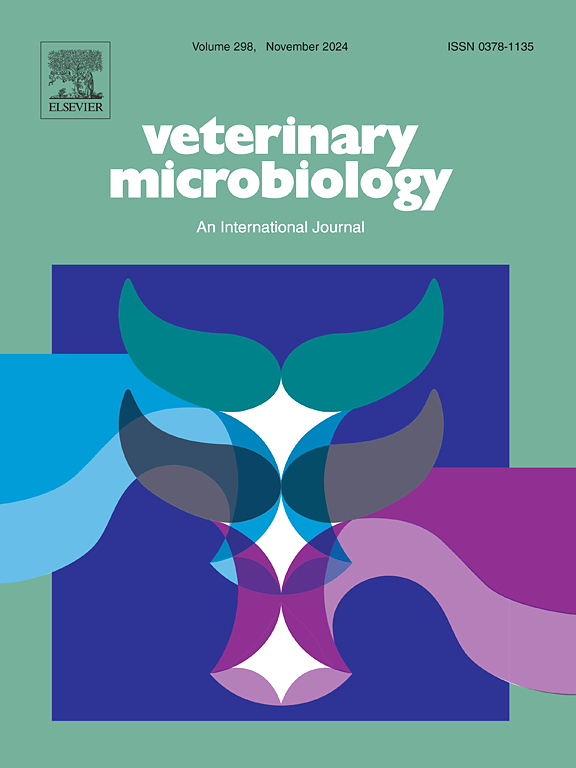Genetic basis of β-lactam resistance in Corynebacterium auriscanis and association with otitis externa in dogs and cats
IF 2.4
2区 农林科学
Q3 MICROBIOLOGY
引用次数: 0
Abstract
Corynebacterium (C.) auriscanis is an opportunistic pathogen regularly isolated from canine otitis externa, an important condition often hard to treat. We found a surprisingly high prevalence of β-lactam resistant isolates of C. auriscanis (47 %), even though β-lactams are not routinely used for otitis externa treatment in Switzerland. To determine the genetic base of this phenotype, a selection of isolates of C. auriscanis with high and low minimal inhibitory concentration values were subjected to whole genome sequencing. Comparative analysis revealed a gene cassette containing three genes (hdfR encoding a LysR-family transcriptional regulator, blaB encoding a β-lactamase related protein and pbp2c encoding a D,D-transpeptidase) as the likely resistance-encoding determinant in the isolates from otitis externa. This locus had previously been described in C. jeikeium as well as C. diphtheriae and was associated with mobile genetic elements. In our six C. auriscanis isolates the pbp2c locus was always associated with the same IS3 family transposase, an association also found on C. diphtheriae plasmid CP091096, indicating horizontal gene transfer between species. To elucidate the function of the three genes in the pbp2c locus, we constructed plasmids with different combinations of these genes, transformed β-lactam sensitive isolates with the plasmids and tested resistance in the mutants phenotypically. By doing so we confirmed Pbp2c to be the primary factor conferring β-lactam resistance and HdfR and BlaB being important for expression and regulation. Interestingly, resistance to all β-lactams including carbapenems was constitutive in one C. auriscanis transformant while an induction effect was visible for the other transformed C. auriscanis strain, C. glutamicum and C. rouxii as previously described for C. jeikeium. Therefore, testing of β-lactam resistance should be done in combination including induction in Corynebacterium spp.
耳棒状杆菌β-内酰胺耐药的遗传基础及其与犬猫外耳炎的关系
耳棒状杆菌(C.)是一种从犬外耳炎中分离出来的机会致病菌,是一种难以治疗的重要疾病。我们发现,尽管在瑞士β-内酰胺不被常规用于外耳炎治疗,但β-内酰胺耐药耳c的流行率惊人地高(47% %)。为了确定这种表型的遗传基础,我们选择了具有高和低最低抑制浓度值的金黄色葡萄球菌分离物进行了全基因组测序。比较分析显示,外耳炎分离株中含有三个基因的基因盒(hdfR编码lysr家族转录调节因子,blaB编码β-内酰胺酶相关蛋白,pbp2c编码D,D-转肽酶)可能是抗性编码的决定因素。这个轨迹以前描述的c . jeikeium c . diphtheriae以及与移动有关的基因的元素。在我们的6株耳耳棘球蚴分离株中,pbp2c位点始终与相同的IS3家族转座酶相关,白喉棘球蚴质粒CP091096也发现了这种关联,表明物种之间存在水平基因转移。为了阐明这三个基因在pbp2c位点上的功能,我们构建了这些基因不同组合的质粒,用质粒转化β-内酰胺敏感菌株,并在表型上测试了突变体的抗性。通过这样做,我们证实Pbp2c是赋予β-内酰胺抗性的主要因子,HdfR和BlaB在表达和调节中起重要作用。有趣的是,对所有β-内酰胺类(包括碳青霉烯类)的抗性在一种金黄色葡萄球菌转化中是组成性的,而对另一种转化的金黄色葡萄球菌菌株、谷氨酸葡萄球菌和rouxii葡萄球菌的抗性则是明显的诱导效应,正如之前对c.j eikeium的描述。因此,在棒状杆菌中进行β-内酰胺耐药试验应结合诱导等方法进行。
本文章由计算机程序翻译,如有差异,请以英文原文为准。
求助全文
约1分钟内获得全文
求助全文
来源期刊

Veterinary microbiology
农林科学-兽医学
CiteScore
5.90
自引率
6.10%
发文量
221
审稿时长
52 days
期刊介绍:
Veterinary Microbiology is concerned with microbial (bacterial, fungal, viral) diseases of domesticated vertebrate animals (livestock, companion animals, fur-bearing animals, game, poultry, fish) that supply food, other useful products or companionship. In addition, Microbial diseases of wild animals living in captivity, or as members of the feral fauna will also be considered if the infections are of interest because of their interrelation with humans (zoonoses) and/or domestic animals. Studies of antimicrobial resistance are also included, provided that the results represent a substantial advance in knowledge. Authors are strongly encouraged to read - prior to submission - the Editorials (''Scope or cope'' and ''Scope or cope II'') published previously in the journal. The Editors reserve the right to suggest submission to another journal for those papers which they feel would be more appropriate for consideration by that journal.
Original research papers of high quality and novelty on aspects of control, host response, molecular biology, pathogenesis, prevention, and treatment of microbial diseases of animals are published. Papers dealing primarily with immunology, epidemiology, molecular biology and antiviral or microbial agents will only be considered if they demonstrate a clear impact on a disease. Papers focusing solely on diagnostic techniques (such as another PCR protocol or ELISA) will not be published - focus should be on a microorganism and not on a particular technique. Papers only reporting microbial sequences, transcriptomics data, or proteomics data will not be considered unless the results represent a substantial advance in knowledge.
Drug trial papers will be considered if they have general application or significance. Papers on the identification of microorganisms will also be considered, but detailed taxonomic studies do not fall within the scope of the journal. Case reports will not be published, unless they have general application or contain novel aspects. Papers of geographically limited interest, which repeat what had been established elsewhere will not be considered. The readership of the journal is global.
 求助内容:
求助内容: 应助结果提醒方式:
应助结果提醒方式:


